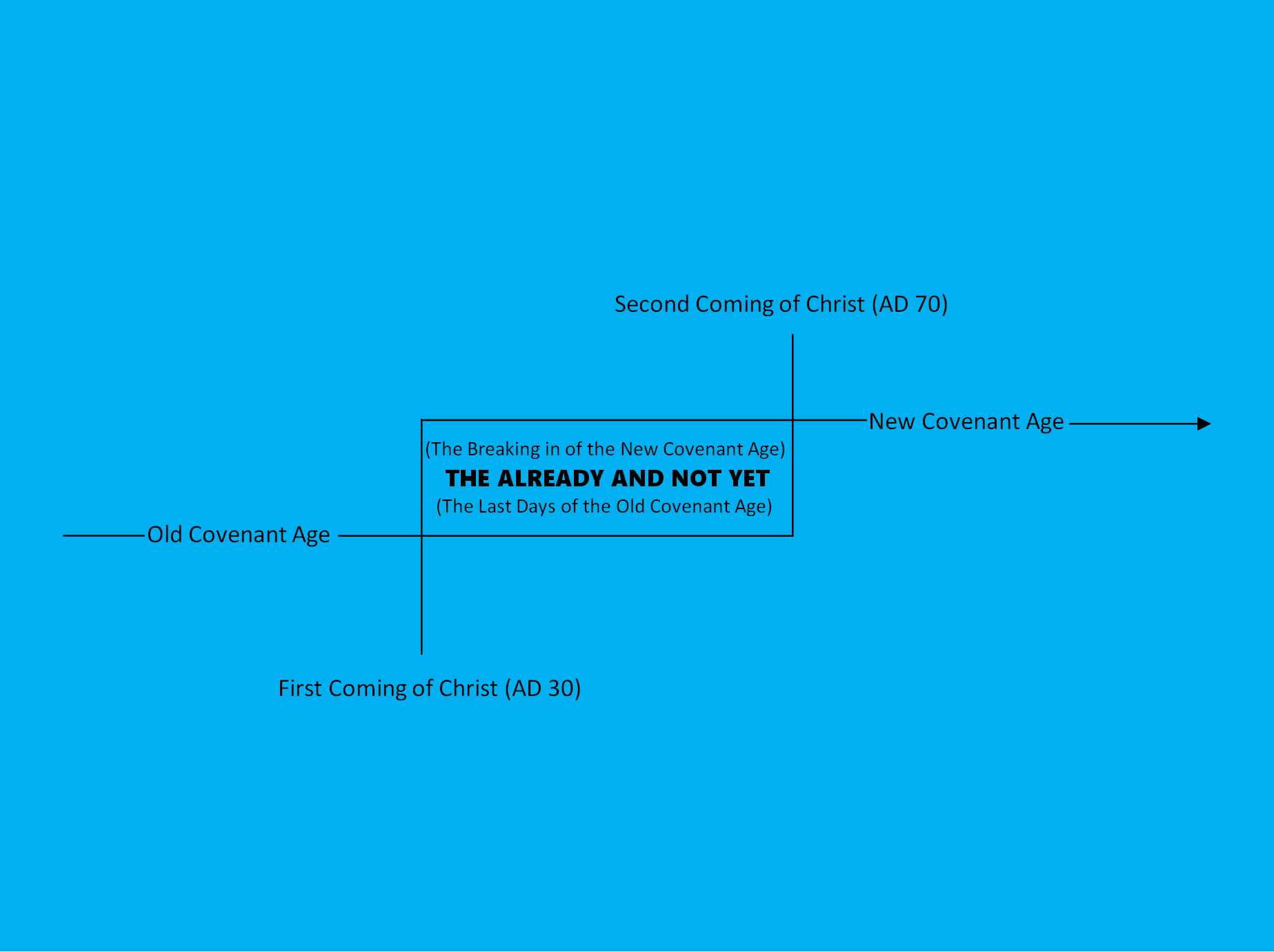The Already and Not Yet

The New Testament is filled with New Covenant realities that had already arrived in part (pre-AD 70), but had not yet arrived in full. Consider the following examples:
Salvation had already arrived in part (2 Tim. 1:9, Titus 3:5, 1 Cor. 6:11), but salvation still had to come in full (Rom. 13:10; 1 Pet. 1:5; Heb. 9:28).
Righteousness had already come in part at the cross (1 Pet. 2:24), yet Righteousness would not come in full until “the elements burned with fervent heat” / the new heaven and earth (2 Pet. 3:13; Gal. 5:5).
Redemption had already happened in part (Eph. 1:7), yet Redemption still needed to happen in full (Eph. 1:14; 4:30; Rom. 8:23).
The Adoption had already happened in part (Rom. 8:15), but the Adoption still needed to happen in full (Rom. 8:23)
The Kingdom of God had already come in part (Col. 1:13; Luke 11:20), but the Kingdom of God still needed to come in full (Mark 9:1, Luke 21:31, Rev. 11:15).
The Gathering of Jews and Gentiles into one new body, Christ, had already begun in part (Eph. 2:12–13), but the Gathering would happen in full at the second coming (2 Thess. 2:1–2, Matt. 24:30–31).
The New Jerusalem had arrived in part (John 4:23, Heb. 12:22–24), yet the New Jerusalem still had to come in full (John 4:21, 23; Rev. 21:2).
The (General) Resurrection had already happened in part (John 5:24–25; Eph. 2:1, 2:6; Col. 3:1–2), but the Resurrection still needed to happen in full (John 5:28–29; 1 Thess. 4:16–17; 1 Cor. 15:51–52; Rev. 20:13).
The New Testament is filled with such New Covenant realities that had already arrived in part, but had not yet arrived in full. In fact, some of these events are spoken about in both the present and future tenses in the very same passage, just a few verses apart (see the redemption example above)! Either the New Testament writers/apostles blatantly and repeatedly contradicted each other–and even their own statements–or there was something more going on here. The already/not yet concept explains this nicely. The New Covenant realities had already arrived in part (pre-AD 70)…but they had not yet arrived in full. And when would they arrive in full? When the Old Covenant age of types and shadows[1] completely vanished away, which would happen at Jesus’ second coming in AD 70.[2] Paul captured this sentiment beautifully in saying (in AD 62/63): “He who has begun a good work in you [saints in Philippi] will complete it until the day of Jesus Christ” (Phil. 1:6).
Note: Just about all Christians acknowledge the “already/not yet” concept. However, while preterists[3] contend it refers to the time period between AD 30 and AD 70, futurists [4] argue it refers to the time period between AD 30 and today–a 2000+ year time period–which would negate the purpose for using such a concept in the first place!
The time period between AD 30 (Jesus’ earthly ministry) and AD 70 (the second coming) was a time of transition. The Old Covenant types and shadows were gradually passing away…and the New Covenant realities were gradually being built up. As the writer of Hebrews said in approximately AD 60: “In that He [God] says, ‘A new covenant,’ He has made the first [covenant] obsolete. Now what is becoming obsolete and growing old is ready to vanish away (Heb. 8:13). The Old Covenant was growing old…and the New Covenant was being built up.
Some theologians take a more proleptic view of these present/future tenses. These theologians argue that the New Covenant realities had not arrived at all–even in part–prior to AD 70. However, because the New Covenant realities were so sure to come–and soon–therefore Jesus and the apostles sometimes spoke about them in the present tense, as if they had already arrived. It’s sort of like when someone today says “dead man walking” to refer to a prisoner on death row. The prisoner is so sure to die–and soon–that he’s said to be already dead. This is what Jesus and the apostles were doing, only in reverse, say the theologians who hold the proleptic view of the New Covenant realities.
Either concept (the “already/not yet” or “prolepticism”) explains these apparent contradictions between the present/future tenses nicely.
For a detailed discussion of the topics discussed in this article, get my book The End Is Here: How the New Testament’s Prophecies Were Fulfilled.
Alex Polyak, The Bible Fulfilled 10/20/24
[1] Types and shadows pointed forward to, or foreshadowed, a greater event, person or reality. Once the greater reality appeared, then the type/shadow passed away. For example, physical circumcision was a type/shadow of spiritual circumcision of the heart (Col. 2:11). The Law was a shadow of the better New Covenant realities (Heb. 10:1). Saturday Sabbath/rest from physical labor was a type/shadow of ultimate rest in Christ (Heb. 3:7–4:16). The physical temple was a type/shadow of the new covenant spiritual temple (1 Pet. 2:4-9). Jerusalem was a type/shadow of the heavenly New Jerusalem (John 4:21–24).
[2] Jesus repeatedly said he would come again within the first century! For example, he told his disciples: “There are some standing here that will not taste death [die] until they see the Son of Man coming in his kingdom” (Matt. 16:28; see also Matt. 10:23, 24:30-34, 26:64, and Rev. 22:12).
[3] Preterists believe the second coming is a past event, based on passages such as Matt. 16:28, 10:23, 24:30-34, 26:64, and Rev. 22:12.
[4] Futurists believe the second coming is a still future event.
